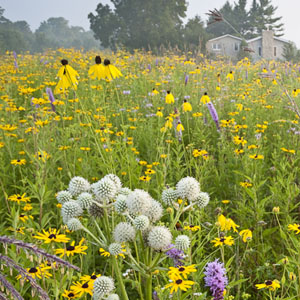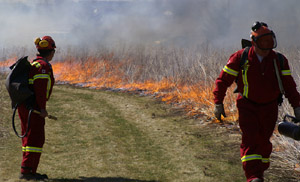My Cart: 0 item(s)
Long-Term Management
WeedingIn the third year of growth and beyond, once your meadow is fully established and mature, the wildflowers and native grasses will work together as a unit to prevent unwanted weeds from establishing within your meadow. The different plants will occupy various levels below the surface creating a virtually impenetrable net-like mesh of roots.WateringLike weeding, watering is unnecessary as your plants work to shade the soil around each root system. At Wildflower Farm, we never water our meadows.FertilizingNo fertilizing is ever necessary for a wildflower meadow. For some species, fertilizer encourages rampant, leggy growth and you will find that these hardy native species are very capable of finding their own food using their large root systems beneath the soil.Controlled Burns or MowingBurning or Mowing your wildflower meadow on a regular rotational basis helps ensure continued success. The first burning or mowing is usually conducted in mid-spring of the third year. The best time to conduct this burning or mowing is generally when the buds of the Sugar Maple tree are just opening. Burning removes the accumulated plant litter from the previous year's growth and exposes the soil surface to the warming rays of the sun. Most wildflowers are "warm season" plants and respond favourably to warm soil temperatures. Burning encourages earlier soil warming and typically increases growth, flowering, and seed production of your wildflowers and native grasses. A mid-spring fire also sets back undesirable "cool-season" weeds such as quackgrass, bluegrass, brome grass, clover, etc., which come up earlier and get a head-start on the wildflowers. By waiting until these undesirable plants have initiated spring growth before burning, the fire will destroy their new growth and set them back, favouring the warm season wildflowers, most of which remain dormant under the soil and thus unharmed by the fire.The timing is critical with burning, it is generally recommended to burn in mid-spring rather than early spring. However, this does not apply to dry meadows with an abundance of early-blooming flowers that would be harmed by a mid-or late-spring fire. Dry meadows should be burned in late fall after most of the native plants have gone dormant, but the non-native cool season grasses are still active. Burning in very early spring can also be done successfully on dry meadows. Burning can usually be instituted at the beginning of the third growing season. At this point, sufficient combustible plant matter is often available from the previous year's growth to support a fire. If there is insufficient fuel to carry a fire, mowing and raking off the material should be substituted. In order to keep your controlled burns ‘controlled’, it is important to have created a buffer strip around the unit you wish to burn. A mowed strip of turf 5-10 feet (1.5-3m) will work well for this (our low maintenance Eco-Lawn turf grass is ideal for this purpose). Never leave a controlled burn unattended! Call your neighbours and local fire department to notify them of your plan. Keep children and pets away from smoke and flames. In some areas burn permits and/or plans are necessary; always know and understand the rules surrounding controlled burns in your area. Frequency of Mowing or Burning: Wildflower meadows respond positively to periodic burning or mowing. Research indicates that spring burnings tend to favour the native grasses and legumes over the wildflowers while fall burning or mowing favours the wildflowers. For this reason, it is recommended to institute a rotational burning or mowing regime. To do this, conduct your second burning or mowing in the fall of the third year of growth. Afterwards you will burn or mow once every year and a half, one time in spring the other in the fall. If burning your wildflower meadow is not an option, mowing can be substituted. Although not quite as effective as burning, mowing and raking off the mowed material is a good substitute. Mowing simulates the effect of fire by removing the previous year's vegetation, and cuts back cool season weeds if mowed in mid-spring. It is important to remove the mowed material to expose the soil surface and encourage soil warming. Do not mow or burn after new plant growth has reached 1 foot (30 cm) or taller as this could damage some of your desirable plants Finally, before you begin a controlled burn, consider researching the various techniques that exist or think about hiring a professional. An out of control burn is not only ineffective, it’s dangerous. If you have a large meadow area, it may be in your best interest (and that of the wildlife) to have established “management units” to build into a burn rotation. Divide your plot into three or four units (you choose the number based on the size of your plot) and burn one of these units every year. This leaves the remaining space untouched where wildlife can seek shelter and food.
Safe Burning Tips 1) Burn in the evening when winds are down, temperatures lower, and relative humidity is higher. A meadow that might roar out of control when burned in the afternoon will be far more controllable in the evening. 2) Always burn into the wind, not with the wind. By burning against the wind, the fire will creep slowly and controllably. 3) Always burn downhill, not uphill. A fire burning uphill pre-heats the fuel ahead of it, so that it burns faster and hotter, making it harder to control. 4) To reduce the height of the flames, simply mow the area just prior to burning. This will knock down the dead grass, and the fire will move more slowly and at a lower level than in an un-mowed meadow. 5) Never burn on a windy day, or when winds are predicted. 6) Burn in mid-spring after cool season grasses and weeds have greened up. This helps kill back the new growth of unwanted weedy species, and the moisture in the green plants helps to slow down the fire. Burning in early spring before green-up does little or nothing to control cool season weeds and favours the warm season plants, and the fire will move more rapidly through the all-brown dead vegetation. 7) Burn when soil moisture is high, such as just after a rain. The water in the soil will slow down the rate of spread of the fire, especially when burning into the wind. If burning your wildflower meadow is not an option, mowing and raking off the mowed material is a good substitute. Mowing simulates the effect of fire by removing the previous year's vegetation, and cuts back cool season weeds if mowed in mid-spring. It is important to remove the mowed material to expose the soil surface and encourage soil warming. Do not mow or burn after new plant growth has reached 1 foot or taller, as this could damage some of your desirable plants. Many ground-nesting birds also build their nests in late spring and mowing or burning at this time could destroy some nests. Mid-spring burning or mowing maintenance leaves enough time for birds to re-nest and successfully raise their young. Once your wildflower meadow has become well-established, it will return year after year with just a minimum of maintenance. Following these guidelines will ensure that your planting will have the very best chance of success, while providing you with a maximum of landscape interest throughout the year! |


